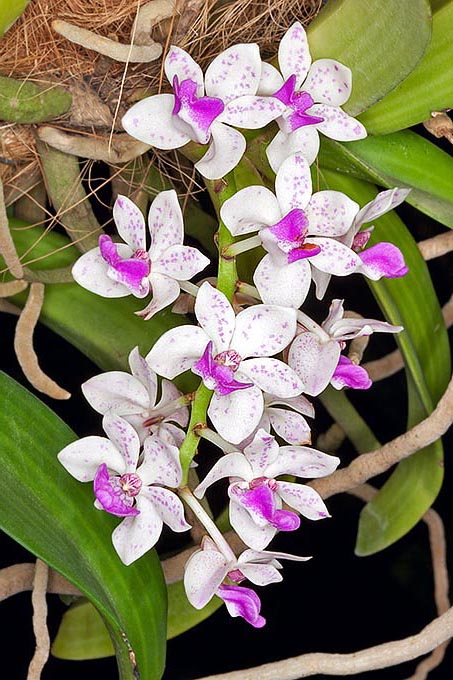Family : Orchidaceae

Text © Pietro Puccio

English translation by Mario Beltramini

The Rhynchostylis gigantea has 12-35 cm hanging inflorescences © G. Mazza
The name of the genus is the combination of the Greek terms “rhynchos” = beak and “stylos” = column, with reference to the shape of the column of the species type; the name of the species is the Latin adjective “giganteus, a, um” = gigantic, with obvious signification.
Common names: foxtail orchid (English).
The Rhynchostylis gigantea (Lindl.) Ridl. (1896) is an epiphytic, monopodial, species with erect stem hidden by the imbricate foliar bases, 4-20 cm long and of about 2 cm of diameter, robust roots of even 1,8 cm of diameter and numerous, thick leaves, alternate, distichous, linear, 15-40 cm long and 3-7,5 cm broad, of dark green colour with pale green longitudinal striae.
Hanging lateral inflorescences, from 2 to 4 at the same time, on short and robust peduncle, racemose, 12-35 cm long, carrying numerous waxy, tight flowers of 2,5-3,5 cm of diameter with white sepals and petals with scattered dots of colour varying from purple to dark violet and white labellum with purple red apical lobes.
The sepals are oblong-elliptic, about 1,4-1,7 cm long and 0,8-1 cm broad, oblong petals, 1,5 cm long and 0,6 cm broad, the labellum is trilobed at the apex, fleshy and slightly pubescent, 1,6 cm long and 0,8-1,2 cm broad, with a short, about 0,5 cm long, spur; the fruit is an obovoid capsule about 5 cm long. The flowers are intensely fragrant and last about two weeks. It reproduces by seed, in vitro, and by micropropagation.
It is probably the most cultivated of the genus, with its numerous, differently coloured, horticultural varieties, it requires medium-high temperatures, with winter lowest values over the 14 °C, even if it can stand sporadic, and for a very short time, drops of some degree if completely dry, high luminosity, avoiding the direct sun, and high and constant humidity, 70-80%, during all the year, with air in constant movement.
During the growing period, the waterings must be regular and abundant, spaced in winter, corresponding to the dry season, when in vegetative stasis. For the waterings and the nebulisations is to be used rainwater, or water by reverse osmosis, or demineralised; the fertilizations, duly distributed and alternated, in way to avoid salts accumulations at the roots, are to be done during the vegetative period preferably with hydro-soluble balanced products, with microelements, at half dosage than what suggested on the package.
It can be mounted on trunks, bark, and cork raft or cultivated in suspended baskets, bare-rooted or, at the most, with big-sized fragments of bark and of charcoal, in order to allow the roots to freely elongate and to quickly dry up after waterings, as it does not appreciate humidity stagnations, cause of easy rottenness. Transplants and repottings are to be done when strictly necessary, as it does not like to be disturbed, by the vegetative restart, which is indicated by the appearance of the new roots.
The species is inserted into the appendix II of the CITES (species whose trade is internationally ruled).
Synonyms: Saccolabium giganteum Lindl. (1833) Gastrochilus giganteus (Lindl.) Kuntze (1891); Anota gigantea (Lindl.) Fukuy. (1944).
→ For general notions about ORCHIDACEAE please click here.
